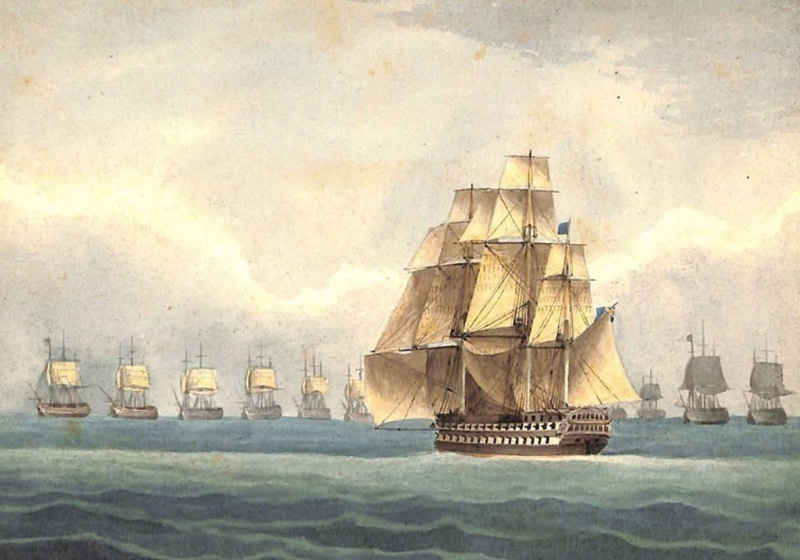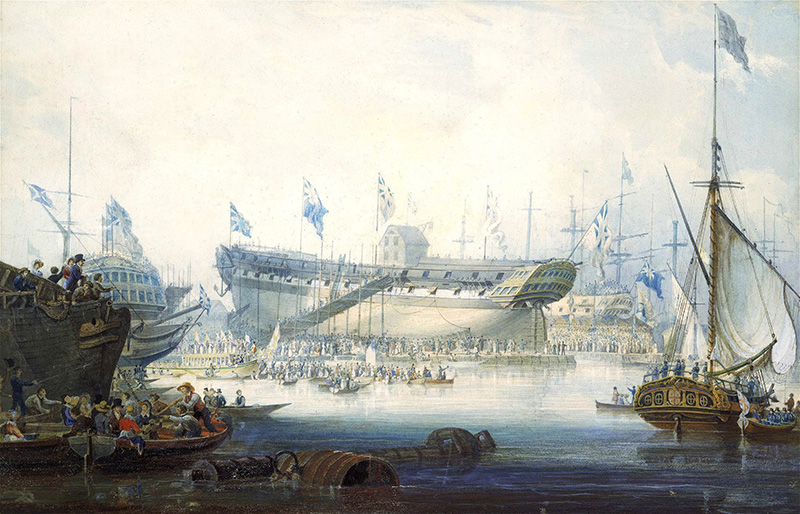Column: Bermuda’s Royal Naval Tanks, Part 4
[Column written by Dr Edward Harris]
In the first part of this series on the Royal Naval Tanks at St. George’s Island, Bermuda, the earliest [1803] published image of the watering facility for British warships was presented and then discussed in part two. In part three, the identities of the warships in the 1803 picture are considered and the 1808 and circa 1815 copies of the 1803 image were introduced. This last part looks at the possibility that Henry Bonham Bax was in Bermuda and American waters late in the War of 1812.
Henry Bonham Bax and American Waters
In considering the possible presence of Henry Bonham Bax at Bermuda and in North American waters, one may refer to the authority of his grandson, Reverend Arthur Nesham Bax, who penned a volume on A Bax Family of East Kent, published privately in 1950. The canon seems to have been unaware of the painting by his grandfather of the Tonnant at Bermuda, or perhaps he would have expanded his suggestion on the young Bax’s service in the War of 1812.
“My grandfather had entered the Navy in 1813 and served in H.M.S. Mulgrave at the blockade of Toulon. It was at that period that he wrote and illustrated the journal, extracts from which are reproduced at the end of this chapter. He was taken prisoner, like many another midshipman, while fetching water in the desolate country of the Camargue at the mouth of the Rhone.
He was released at the fall of Napoleon [May 30 1814] and seems to have seen service in the American War [emphasis added]. Peace was signed with the U.S.A. on Dec 24 1814, but it took time to make this known to ships scattered on the high seas. We have a cutlass of unusual design, with a serrated edge on the non-cutting side which is said to be a trophy of the capture of an American ship by boarding.”
Fig. 17. “The Mulgrave entering Gibraltar Bay.” [H. B. Bax, 1813. Private collection.]
As Napoleon Bonaparte had abdicated on 11 April, 1814, Henry was not released for almost two months. Assuming that he was back in Britain in June, we should look for the whereabouts of HMS Tonnant at that time, although he could have taken another Royal Navy ship to Halifax or Bermuda and joined the flagship there, if on that vessel he did indeed serve in the American theatre.
The Tonnant was captured from the French in 1798, the year Henry was born, by Nelson at the Battle of the Nile and went on to be with the admiral at Trafalgar in 1805. After other successful encounters with the French, Tonnant was late to join the War of 1812, sailing for Halifax with troops for America in early April 1814.
On 2 August, the ship, in concert with HMS Euryalus left Bermuda for the Chesapeake, under the flag of Vice Admiral Sir Alexander Cochrane, uncle of the famous Earl Dundonald, arriving for their date with destiny at Baltimore on the 14th. After dining with Cochrane on the 7th September on Tonnant, Francis Scott Key was held in the American “truce vessel sloop” from where he saw the bombardment of Fort McHenry and penned “The Star-Spangled Banner”, later the national anthem of the United States of America.
In October, Tonnant left Halifax for Guadaloupe, where Cochrane had been governor a few years previous, accompanied by a fleet including the Bermuda-built HMS Morgiana, later an anti-slaver on the West Coast of Africa. By the first week of December, 1814, the Tonnant was off the Chandeleur Islands in the Gulf of Mexico, in preparation for the Battle of New Orleans and other last conflicts of the War of 1812, which ended a few weeks later. In March the following year, the warship was at Bermuda, whence it left for the last time on 29 April, 1815, for home waters, probably via Halifax, arriving in May 1815. Cochrane had been the Commander-in-Chief of the North America Station, which included Bermuda and Halifax, for both of those years, which saw his last service in a war setting.
Fig. 18. “The Mulgrave joins the Fleet off Toulon under the command of Sir Edward Pellew.” [H. B. Bax, 1813. Private collection.]
Meanwhile, Henry had been in French captivity but was freed in late May, presumably to a ship off the Camargue and Toulon coasts, but here one may enter HMS Euryalus and a little speculation, after a review of HMS Mulgrave. That vessel, presumably with Henry aboard as a naval cadet or midshipman, was ordered to the Mediterranean in late April 1813 and took part in the Blockade of Toulon, as the flagship of Rear-Admiral Sir Richard King, who, for interest, had joined the Royal Navy at the age of six, seeing action at 8 years old at the Battle of Madras!
While we do not know the date at which Henry was captured in the Camargue, peace with the French came on the 11th April 1814 and in early September, Mulgrave was “paid off into the Ordinary at Plymouth”, spending her last years as a Lazaretto [quarantine] hulk at Pembroke Dock in Wales. It is not known if Bax rejoined the warship after his release.
On 21 April, 1814, Euryalus and HMS Undaunted [under Thomas Ussher’s command, later Superintendent of the Bermuda and Halifax dockyards] were at Marseilles, when news of Napoleon’s defeat reached them. Ussher and Undaunted would later convey the emperor to confinement on the island of Elba. In June, from Gibraltar, Euryalus sailed for Bermuda with a convoy of troop ships and one may suggest that that is how Henry got to the mid-Atlantic island, where he may have joined the flagship Tonnant.
That may be why, in copying the 1803 image from the Naval Chronicle, he named the ship entering Murray’s Anchorage as the Tonnant, not the Euryalus. These suppositions are possibly contradicted by the painting by Bax of HMS Mulgrave passing Gibraltar “homeward bound”, so that Henry may have been back in Britain and taken another vessel to Bermuda in mid-1814.
Fig. 19. “The Mulgrave in Company with the San Josef of 120 guns passing the Strait of Gibraltar homeward bound.” [Private collection.]
Be that as it may, Henry Bonham Bax, as but a teenaged midshipman could have seen action in several of the major naval and land actions of the War of 1812, from the Chesapeake to the Gulf of Mexico, with visits to the naval bases at Bermuda, Halifax and possibly Jamaica and Antigua. Upon his likely return to Britain in the summer of 1815, his whereabouts for his last two years in the Royal Navy are not known.
In 1817, he joined the maritime service of the Honourable East India Company, commanding, among others, the brand-new HEIC Edinburgh, launched in 1825, on at least three trips to the Orient. In the 1840s, he became one of the Brethren of Trinity House, London, which was responsible for navigation aids, such as lighthouses, around Britain and some of his later paintings reflect that interest. Thus, the connection between the artist Henry Bonham Bax and Bermuda may remain a mystery for some time to come.
Fig. 20. The “Launch of the Honble, East India Compy’s Ship EDINBURGH, Captain Henry Bax” on 9th November 1825.
- Dr Edward Harris
Read More About
Category: All





